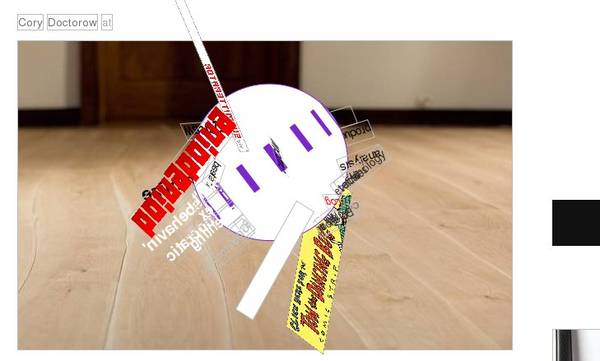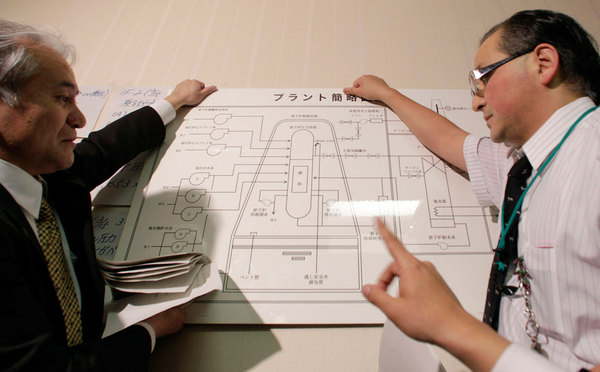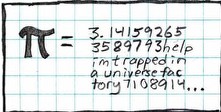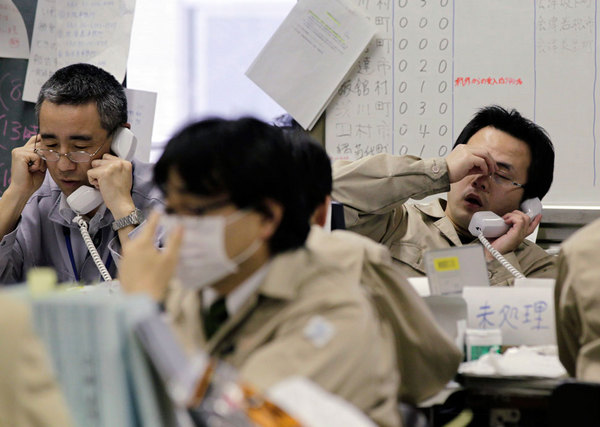The Latest from Boing Boing |  |
- Fraudsters break all records in Japan relief ripoffs
- Inside Saif Gadaffi's squatted London mansion, reclaimed by Libyan exiles
- Turn any web-page into a game of Katamari Damacy
- Curvy wood floors use CAD/CAM to minimize wastage
- Report: US military worked to put out fire at Japan's Fukushima No. 4 reactor
- Radiation: Dose and Risk
- Japan: Third blast at Fukushima nuclear plant, fire at reactor 4, workers leave plant, crisis worsens (UPDATED)
- Marshall Brain's weekly science and technology news roundup podcast
- So. California's San Onofre nuclear plant, near fault line and sea, built to withstand less than Japan plant
- Japan: Robotic snakes to the rescue
- Japan quake and tsunami: one family, reunited
- Japan nuclear crisis update: IAEA director briefs media, March 14
- $10 drug now $1500 after FDA grants monopoly
- Stephen King sticks up for unions
- Fake but cool video hacking in Times Square
- 16th century engraved grotesque masks
- Japan: new problems at third reactor; meltdown and "catastrophic release of radiation" feared
- How to: Celebrate Pi Day
- Geologist explains some more science behind Japanese earthquake & tsunami
- Papercraft zombie-a-month calendar
- Mac switcher reaches the "wow, iTunes sucks" brick wall
- My favorite Pi joke
- Celebrate Pi Day (3/14) with a spherical pie!
- 4G-ish
- HOWTO make Pop Rocks
- Japanese nuclear plants: Some good news
- Blowing up a microwave by cooking a sealed bottle of liquid
- Japanese nuclear plants: Some thoughts on how to stay informed without going crazy
- On female characters in games
- Nuclear recycling has risks and benefits
| Fraudsters break all records in Japan relief ripoffs Posted: 15 Mar 2011 04:52 AM PDT Fraudster scumbags have beaten all records in setting up fake Japan relief pages, fielding more than 1.7 million malware pages, 419 scams trading on the Japanese disasters, 50+ fake domains with "Japan tsunami" or "Japan earthquake" in their URLs. MacWorld recommends donating via the Red Cross, or other established charities that you're familiar with. Monday, Trend Micro reported on one phishing site that included "japan" in its URL, saying that the site was harvesting email addresses and other personal information from unsuspecting users.Fraudsters prey on Japan earthquake charity donations |
| Inside Saif Gadaffi's squatted London mansion, reclaimed by Libyan exiles Posted: 15 Mar 2011 04:54 AM PDT  The New Statesman's Laurie Penny has gotten into Saif Gadaffi's multi-million-pound mansion in London's We drink stewed tea from Saif's best china and eat cheese sandwiches using his silver cutlery, while the young man, Abdulla, tells me about how his uncle was "disappeared" by Saif's father. "In Libya, people disappear all the time. There was a prison massacre where 1,200 people died. They poured cement over the bodies." Abdulla nervously adjusts his glasses. "It's important that people know we're not creating a civil war for no reason.Inside the Saif house (Thanks, Laurie!)
|
| Turn any web-page into a game of Katamari Damacy Posted: 15 Mar 2011 12:47 AM PDT  The KatHack is a great little Javascript bookmarklet; simply paste the text below in your location bar and you can turn any page into a fabulous game of Katamari Damacy. I've been trying to get this to work since it showed up on MeFi on Saturday, but the site's been down. Now, though, it's working beautifully. Kathack "was the winner of the 2011 Yahoo HackU contest at University of Washington." javascript:var i,s,ss=['http://kathack.com/js/kh.js','http://ajax.googleapis.com/ajax/libs/jquery/1.5.1/jquery.min.js'];for(i=0;i!=ss.length;i++){s=document.createElement('script');s.src=ss[i];document.body.appendChild(s);}void(0);Katamari Hack (Thanks, JohnnyForeigner, via Submitterator!)
|
| Curvy wood floors use CAD/CAM to minimize wastage Posted: 15 Mar 2011 12:34 AM PDT  Bolefloor makes hardwood floors that eschew the wastefulness of straight lines. Instead, they use computerized analysis to calculate puzzle-fit lengths that follow the curves and irregularities of the uncut logs, producing an organic, irregular mosaic that I find much preferable to the straight lines of traditional wood floors. Bolefloor technology combines wood scanning systems, tailor-made CAD/CAM developments and innovative optimization algorithms for placement software developed by a Finnish engineering automation company and three software companies in cooperation with the Institute of Cybernetics at Tallinn University of Technology.Bolefloor (Thanks, Error27, via Submitterator) |
| Report: US military worked to put out fire at Japan's Fukushima No. 4 reactor Posted: 15 Mar 2011 12:58 AM PDT Asahi reports that according to TEPCO, the operator of the troubled nuclear power plants in Japan, U.S. military personnel were involved in fighting the fire in Reactor Number 4 of the Fukushima Daiichi nuclear power plant. A Reuters item here says TEPCO asked US military forces in Japan for help. The fire was successfully extinguished. I can't find details on the reported US military assistance at this time, and have put out queries to military public affairs contacts. English translation of Asahi item here. Related: Third blast at Fukushima nuclear plant, fire at reactor 4, workers leave plant, crisis worsens (UPDATED) |
| Posted: 14 Mar 2011 07:30 PM PDT So, I'm in process on putting together a post that will, hopefully, add some context to the concept of radiation exposure and relative risk. It's coming together slowly because (shocker) many of America's nuclear energy and radiation scientists are kind of busy right now, and answering my questions isn't the first thing on their to-do lists. But, in the meantime, I did want to share one really interesting tidbit that I picked up from an email exchange with Kathryn A. Higley, PhD, head of Oregon State University's Dept. of Nuclear Engineering & Radiation Health Physics. One of the key things I'm trying to better understand, myself, right now, is the connection between radiation dose experienced, and risk of cancer later. It turns out, this is a little weird—both because of how the science works, and because of the somewhat arbitrary cutoff lines we've set for concepts like "annual dose". Dr. Higley doesn't have good data on specific radiation doses humans are being exposed to at the Fukushima Daiichi power plant—partially, because that information keeps changing as the situation changes. But she told me that one plant worker received a 10 rem dose—twice the annual occupational dose, i.e. twice what regulators have deemed safe for someone who works in a nuclear power plant to receive every year. By contrast, somebody who gets a CAT scan is exposed to a dose of 1-2 rem. But what kind of risk does that actually translate into? The outcome is a lot less scary sounding than I'd expected. "We assume (and it is subject to some strenuous scientific debate) that any incremental exposure to radiation can increase your risk," Dr. Higley wrote to me. "But the radiation worker that was reported to get a dose of 10 rem would only see his/her risk go up by .5 - 1%." That is: Twice the annual safe dose of radiation equals a 1% increase in a person's lifetime risk of developing cancer. That's not trivial. But it's also not something I'd panic over, either. In fact, I think this is what makes debates over nuclear energy so damn complicated. Reasonable people can look at the increased risks, and come to completely different conclusions about whether or not those risks are acceptable. |
| Posted: 14 Mar 2011 09:05 PM PDT  Image (Reuters): Tokyo Electric Power officials hold an illustration of a nuclear plant as they answer reporters' questions at the disaster center in Fukushima, northern Japan March 15, 2011. A fresh explosion rocked a damaged Japanese nuclear power plant on Tuesday where engineers have been pumping sea water into a reactor to prevent a catastrophic meltdown in the wake of a devastating earthquake and tsunami. Some plant workers were ordered to leave the site, a sign that the situation may be getting more serious at the complex that was damaged by a massive earthquake and tsunami. A third explosion has struck Japan's beleaguered Fukushima nuclear power plant in as many days, after Friday's 9.0 earthquake and subsequent tsunami. This time, the plant's operator, Tokyo Electric Power Company (TEPCO) says radiation levels reached 8,217 microsieverts per hour near the plant's front gate, roughly two and a half hours after the blast.
Anyone in this kind of environment would be exposed to more than 3 years' worth of naturally occurring radiation within a single hour. At the time of this blog post, Japan's Prime Minister is expected to address the nation on national TV shortly (NHK live stream here). [ UPDATE, 710pm PT: Prime Minister Kan is on now, and saying that the possibility of nuclear leaks is increasing [corrected from earlier, erroneous Reuters item]. Residents within 20 km of the site are asked to evacuate ASAP; those between 20 km and 30 km are requested to stay inside. The blast damaged an essential steel containment structure, and larger leaks of radioactive material are now believed to be immiment. Chief Cabinet Secretary Edano followed the Prime Minister, and said a fourth reactor at the damaged nuclear plant is now on fire, with even more radiation released. Reactor No. 4 was not in operation at the time of the earthquake. The reactor contains spent fuel, not fuel rods. As was the case with the explosions at the No. 1 and No. 3 reactors, a Hydrogen explosion seems to have taken place with No. 4. Some foreign objects fell into reactor No. 4, which caused problems. We're seeing radioactive substances being released, says Edano, and reactor No. 4 is now exposed. The blast at No. 2 reactor came 30 minutes after the incident at No. 4. A hole has been observed in the No. 2 reactor; there is a high possibility of container vessel damage for this reactor. The monitoring levels they are dealing with are now in millisieverts, not microsieverts as previously discussed. The radiation levels being released now can impact human health, Edano says, but the danger should decrease with distance from the site. 800 plant workers were evacuated at Fukushima Plant 1. Fifty workers are still working on emergency cooling efforts. Water injection operations are continuing at reactors No. 1, 2, and 3 at Fukushima Plant 1. These operations are going smoothly, Edano says, and they beleive the cooling process is effective, but the problem is how to maintain the cooling. "At the site right now, workers are trying to take corrective action to put out the fire. We will continue injecting seawater." Edano urged the public to stay calm, and go about their daily lives. He was asked whether there is a possibility of radiation danger spreading to Tokyo. He replied that "minimal" amounts of radioactive material could spread to far locations, but the levels should not be harmful to human health. ] [UPDATE, 8:26PM PT: Kyodo News reports that the fire at Reactor No. 4 has been extinguished.] Earlier version of this blog post pre-press conference follows below.
Radiation is feared to have leaked after the container vessel suffered damage at the No. 2 reactor of the quake-hit Fukushima No. 1 nuclear power plant Tuesday morning, Tokyo Electric Power Co. said. The utility also admitted that a critical situation called ''meltdown'' in which fuel rods melt and are destroyed is possible at the plant where three reactor cores are believed to have partially melted following Friday's magnitude 9.0 earthquake that hit northeastern and eastern Japan.
It was not immediately clear if the blast was caused by the buildup of hydrogen, as occurred at the two other reactors at Daiichi -- one on Saturday and the most recent one on Monday, when there was also a large explosion at the No. 3 reactor. Some early reports in the Japanese press suggested the latest explosion amounted to a different and more critical problem than the previous two. Related reading in today's Times: "As Japanese nuclear power officials face the prospect of struggling for months to control several crippled reactors, a basic question arises: will there be enough workers to keep doing the job? "
|
| Marshall Brain's weekly science and technology news roundup podcast Posted: 14 Mar 2011 08:01 PM PDT  Marshall Brain is the founder of howstuffworks.com (which he sold to Discovery Networks in 2007 for $250 million). Brain records a daily podcast called BrainStuff, in which he explains how machines and systems work. I enjoy these podcasts, but a few weeks ago he started devoting Fridays to what he calls his "weekly science and technology news roundup," and I've become an instant fan of these outstanding summaries of interesting things happening around the world. The podcasts are about 20 minutes long, and in each one, Brain covers about 20 different news items. Marshall Brain is the founder of howstuffworks.com (which he sold to Discovery Networks in 2007 for $250 million). Brain records a daily podcast called BrainStuff, in which he explains how machines and systems work. I enjoy these podcasts, but a few weeks ago he started devoting Fridays to what he calls his "weekly science and technology news roundup," and I've become an instant fan of these outstanding summaries of interesting things happening around the world. The podcasts are about 20 minutes long, and in each one, Brain covers about 20 different news items. In his most recent roundup, Brain covered the earthquake and tsunami in Japan, the laser blaster that Cory blogged about on Boing Boing last week, a solar powered, semi transparent, experimental television set from Samsung, a report that found that people who take naps in the afternoon do much better on mental performance tests than people who don't take naps, a pregnant woman who conducted her own experiment to see if chivalrous behavior existed on the New York City subway system, a scary report that shows that ice loss in Antarctica and Greenland has been accelerating, a way to install the Android operating system on a Nook e-book reader to turn it into a $200 tablet computer, and a lot more. Many of the things Brain covers in his news Roundup are also included in his terrific Interesting Reading reports on his blog. |
| Posted: 14 Mar 2011 05:59 PM PDT  (photo by Jason Hickey) A spokesman for Southern California Edison, the operator of the San Onofre nuclear power generating station (between LA and San Diego, the big white dome-shaped thing off I-5) was trying to calm fearful Southern California residents today when he explained that the 84-acre generating station was built to withstand a magnitude 7.0 earthquake. He also told local media that a 25-foot-high "tsunami wall" of reinforced concrete stood between the plant and the immediately adjacent Pacific ocean. Well, that's nice. But this Southern California resident remains concerned: the earthquake that devastated Japan last Friday, throwing various nuclear power plants into crisis and sparking worldwide fears of a major nuke accident, was a 9.0 "great quake." And the tsunami that soon followed? That was 33 feet high. When the plant was built 42 years ago (42 years! That's forever in design-years!), scientists predicted a 6.5 quake could strike the plant. The designers of the San Onofre plant built with a higher threshold in mind. But man, not high enough, for my money. There's a geological fault just 5 miles offshore, and good odds we'll be hit by a "great quake" of our own, sooner or later. For context: those documents from TEPCO, operator of the stricken Fukushima plant in Japan, that were obtained by reporters at the Wall Street Journal? They show that engineers tested the Fukushima plant to withstand a quake up to magnitude 7.9. |
| Japan: Robotic snakes to the rescue Posted: 14 Mar 2011 03:05 PM PDT  CNET: "Rescue robots are making their way to parts of Japan affected by the massive earthquake and tsunamis that devastated coastal areas Friday and in the days following, leaving nearly 6,000 people dead or missing. A team from Tohoku University led by Satoshi Tadokoro is apparently en route to Sendai with a snakelike robot that can wriggle into debris to hunt for people." |
| Japan quake and tsunami: one family, reunited Posted: 14 Mar 2011 03:00 PM PDT "Shoko Ono, the 23-year-old who took the $800 taxi ride from Tokyo, completes the last part of her journey to her parents' house on foot. The family dog welcomes her to a home largely undamaged by the earthquake, and a mother stunned by her arrival. There's no hugging or kissing, just gasps of surprise and shock as she stands and bows to her parents. They bow, too -- the emotion of the moment palpable, even though nobody touches anyone."—NPR All Things Considered (audio here). |
| Japan nuclear crisis update: IAEA director briefs media, March 14 Posted: 14 Mar 2011 02:57 PM PDT IAEA Director General Yukiya Amano and various IAEA nuclear safety officers briefed media today on the current state of the unfolding nuclear crisis in Japan. Audio and video are available here. |
| $10 drug now $1500 after FDA grants monopoly Posted: 14 Mar 2011 01:44 PM PDT A progesterone hormone injection, used to prevent preterm labor, used to be $10 a shot. Now that the FDA has assigned an exclusive right to create the easily-made formula to one company, KV Pharmaceuticals, the price has risen to $1500. Almost all of it is pure profit, and KV Pharma did not develop the drug or pay for its trials: the taxpayer did, via the National Institute for Health. It is said to be the only drug proven to prevent pre-term birth, and an expert cited by ABC News suggests that the profession was snookered into supporting the assignment as a quality standardization measure. |
| Stephen King sticks up for unions Posted: 14 Mar 2011 01:17 AM PDT Here's video of Stephen King addressing a pro-labor, anti-Tea-Party rally in Sarasota, Florida, explaining why he supports redistributive taxation policy and unions, and opposes the anti-union laws being pushed by Scott Walker and other right-wing governors. |
| Fake but cool video hacking in Times Square Posted: 14 Mar 2011 12:00 PM PDT [Video Link] Johnny Foreigner says: "No idea if this is for real - looks like a guy has created a video repeater that "somehow" manages to overwhelm the inputs of any screen in the vicinity. The demo shows the inventor taking over a couple of small screens at ground level, before attaching the device to a huge red balloon and floating it up high to hack bigger screens up above." It's got to be fake, but I like it! Do you think you could get in trouble for using a tethered balloon in Times Square, though? (Submitterated by Johnny Foreigner) |
| 16th century engraved grotesque masks Posted: 14 Mar 2011 01:14 AM PDT  I love these zoological grotesque masks from the 16th century. They were designed by Cornelis Floris and engraved by Frans Huys. They were originally published in Antwerp in 1555 by Hans Liefrinck. The original collection was called something like "Ingenious portrayal of several types of mask. Useful for painters, stoneworkers [and other trades]." Basically, they're clip-art for stonemasons. |
| Japan: new problems at third reactor; meltdown and "catastrophic release of radiation" feared Posted: 14 Mar 2011 10:37 AM PDT New York Times: "The risk of a meltdown spread to a third reactor at a stricken nuclear power plant in Japan on Monday as its cooling systems failed, exposing its fuel rods, only hours after a second explosion at a separate reactor blew the roof off a containment building." Related: in a press conference today, the head of the IAEA said it is "unlikely that the accident would develop" like Chernobyl, citing the design and structure of the nuclear plants. Cold comfort: just because the details are different doesn't mean the damage potential is any less. |
| Posted: 14 Mar 2011 10:18 AM PDT New Scientist has put together an extensive list of Pi Day-related events and features—including the Pi Phone, a number you can call to hear the digits of pi being read. |
| Geologist explains some more science behind Japanese earthquake & tsunami Posted: 14 Mar 2011 10:22 AM PDT  Fabrizio Bensch / Reuters I've been reading about some pretty astounding impacts of last week's 8.9 earthquake. For instance, there's the fact that the quake not only shook Japan, it moved the country. Specifically, pushed it Westward by about 8 feet. The US Geological Survey confirmed this to Space.com, as well as the fact that the quake shifted Earth's axis by 6.5 inches. And then, there's the news from a lab at NASA's Jet Propulsion Laboratory in Pasadena, Calif., where geophysicist Richard Gross has found that the quake also sped up Earth's spin, just a little a bit. Days are now 1.8 microseconds shorter, by his estimation. How does all of this make sense? I've got a better understanding now, having read this great Scientific American guest blog post by geologist and blogger Chris Rowan. He covers all sorts of good information about the earthquake and the tsunami. From how we can tell that Japan moved, and why ... to what's going on with the changing numbers on how powerful this quake really was.
|
| Papercraft zombie-a-month calendar Posted: 14 Mar 2011 01:09 AM PDT  Mid-March is generally a good time to get a deal on a calendar, and the Fold-Your-Own Zombie: 2011 Wall Calendar is a good candidate. 12 papercraft zombies, waiting for you to cut, glue and fold. Mid-March is generally a good time to get a deal on a calendar, and the Fold-Your-Own Zombie: 2011 Wall Calendar is a good candidate. 12 papercraft zombies, waiting for you to cut, glue and fold. Fold-Your-Own Zombie: 2011 Wall Calendar (via Super Punch!) |
| Mac switcher reaches the "wow, iTunes sucks" brick wall Posted: 14 Mar 2011 12:04 PM PDT The excellent Charlie Brooker is going through all the standard stages of the Windows-to-Mac transition. First mocking them as toys, then not caring about their superiority, he ultimately embraced the truth and made the leap. He has just reached the first stage of post-Switch Apple Zen: accepting that iTunes is a turd that hasn't moved on from the DRM era of media syncing. He is also evidently on the threshold of "skeuoomorphic design is nauseating." |
| Posted: 14 Mar 2011 09:58 AM PDT  In honor of Pi Day, here's my all-time favorite Pi joke (incidentally, this was also the first XKCD strip I ever saw!). In honor of Pi Day, here's my all-time favorite Pi joke (incidentally, this was also the first XKCD strip I ever saw!). |
| Celebrate Pi Day (3/14) with a spherical pie! Posted: 14 Mar 2011 09:55 AM PDT  She Creates Stuff has a great HOWTO that uses a spherical cake mold to make a ball-shaped, sealed pie-crust that you can stuff with your favorite jammy gooey goodness, and so celebrate the mysterious infinitude that is Pi. To create it, I used a Wilton Sports Ball pan. This pan has two half spheres and two ring stands. It is intended to be used to bake a round cake but, instead, I formed a crust around it. Once baked, I filled the crust and cemented it together with white chocolate.Pi Day - Spherical Pie (Thanks, starshipminivan, via Submitterator!) |
| Posted: 14 Mar 2011 09:58 AM PDT "4G" is meaningless. "4G" phones and modems offer less bandwidth than 3G ones, carriers are rebadging 3G gadgets as 4G ones, and even where it's available, speeds are throttled to the kilobit range. PC Mag point out that there is nothing to stop carriers like AT&T lying in their ads: "AT&T's tactic seems to ruin the entire idea of 4G so as to cloud the picture." [PC Mag] |
| Posted: 13 Mar 2011 12:18 AM PST Chickflix has posted an Instructable that pierces the veil of mystery and describes how to mix your own Pop Rocks at home. The secret ingredient turns out to be pretty mundane, alas -- I always assumed that they were filled with some violent, rare substance that ground its way through my guts on the way out. On the other hand, now that the secret is in the open, it paves the way for exotic Pop Rock flavors, such as French mustard, roast beef, and pineapple. Pop Rocks! (via Make!) |
| Japanese nuclear plants: Some good news Posted: 14 Mar 2011 09:05 AM PDT While I was writing the previous post, recommending World Nuclear News as a not-unbiased, but-at-least-well-organized source of information about what's happening at the Fukushima Daiichi and Daini power plants, I noticed that they'd posted a new article saying that three of the four reactors at Fukushima Daini are now in cold shutdown—i.e. you don't have to worry about them anymore. Because, as I said, I wouldn't rely on WNN as a sole source of information, I ducked over to the IAEA—an international regulatory body to whom the power plants' operators must report—to see what they had to say. As of 5:15 am Central European Time, IAEA can confirm that one of the units is in safe cold shutdown, another is on its way there, and the last two are undergoing some final repairs to residual heat removal systems. See what I mean about the conflicting information? I trust the IAEA on this, so let's not get too excited about multiple cold shutdowns until they confirm it. But the news out of Fukushima Daini—always the less-damaged of the two facilities—is still sounding pretty good this morning. |
| Blowing up a microwave by cooking a sealed bottle of liquid Posted: 13 Mar 2011 11:50 PM PDT Tesla 500 likes to blow up old microwaves so that he can harvest their transformers, gang them up and turn them into buzzing, instantaneously lethal apparati that burst into flames. He has put a lot of thought into the optimal way to blow up a microwave, and has settled on blowing it up by putting a bottle of sealed liquid in the microwave and turning it on (and leaving the room). In this video -- the latest in a series -- he experiments with a Kahlua bottle that he's sealed with silicone, and manages to produce an explosion that shocks even him. Here on Reddit, he describes the delicious sense of suspense he experiences while waiting for the microwave to blow: "The sound when these things explode is hard to describe, it's a very loud low frequency WHUMP, very unlike a gunshot or chemical explosion. I've only ever heard it from the next room, so I can't imagine how loud it is in the room! The wait is the killer, you have no idea when it's going to happen, just that it takes approximately 20 minutes. As Adam Savage said, that kind of stress cannot be good for you!" Needless to say, you shouldn't try this at home, or anywhere else. |
| Japanese nuclear plants: Some thoughts on how to stay informed without going crazy Posted: 14 Mar 2011 08:42 AM PDT Breaking information about what is going on at the two Fukushima nuclear power plants—Daiichi (where most of the trouble is) and Daini—has often conflicted with other reports, points out Cristine Russell in The Atlantic. She's criticizing the round-the-clock cycle of cable news coverage for confusing the public, and adding more fear and stress to an already fear-and-stress-filled situation. A big part of the problem: Knowing which sources to trust. Here's two recommendations from Russell that earn big thumbs up from me:
I'd add to that a recommendation for World Nuclear News. They are an industry publication&mash;funded by the World Nuclear Association, which is a professional organization that does education within the nuclear industry, and promotes nuclear power to the general public. Given that, I wouldn't rely on them as an only source. But they are doing a really good job of regularly (but not too regularly) updating what is happening at the various reactors and, more importantly, keeping that information in context, so that it's easy to keep track of how many reactors are involved, and what is happening at each. That's a pretty important feature for anyone trying to follow this story from home. Better yet, when new news comes in, they've been updating directly in the previous story, and making notes at the top of the page about what was updated. It seems like a small thing, but it can help a lot if, like me, you've been feeling a bit like you're drowning in information. Keep in mind, though: They seem to be abandoning article pages at the end of each day, and starting a new page, which then gets all the new updates. So if you're looking at an article from Sunday, you're seeing everything that happened that day, but not what's happened since then. |
| Posted: 14 Mar 2011 08:58 AM PDT [Video Link] "The reason this topic has been so long in coming is because we've been waiting for the industry to provide us with a good topical example of a well-done female character. Unfortunately, nothing really helpful has come out." [Escapist via Metafilter] |
| Nuclear recycling has risks and benefits Posted: 14 Mar 2011 08:09 AM PDT  Yomiuri Yomiuri / Reuters There was another explosion at a Japanese nuclear power plant today. Same power plant, same cause, different reactor. (Also, same outcome: The outer layer of the buildings surrounding the reactor was blown apart, but, again, there was no increase in radiation following the blast. The reactor, itself, is still contained.) This particular reactor—Fukushima Daiichi #3—is a little bit different, though, and the Wall Street Journal does a good job of explaining why.
It's worth noting that this is one of the reasons why an interdisciplinary faculty group from MIT advised against the United States adopting a nuclear fuel recycling program. Primarily, the group was worried about proliferation—the process of recycling the fuel leaves more opportunities for potentially dangerous materials to fall into the wrong hands. MIT didn't rule out recycling completely—just advised against it in the near term. But reading their report took me from thinking of nuclear recycling as simply common sense, to having a much more nuanced understanding of both the rewards and the risks. I'd recommend this report as a relatively readable primer on the nuances of nuclear energy, in general. The full thing is 12 chapters long, but the executive summary is a quick read, and it's all available for free online. |
| You are subscribed to email updates from Boing Boing To stop receiving these emails, you may unsubscribe now. | Email delivery powered by Google |
| Google Inc., 20 West Kinzie, Chicago IL USA 60610 | |


 ~ 2 Cups Sugar
~ 2 Cups Sugar
No comments:
Post a Comment